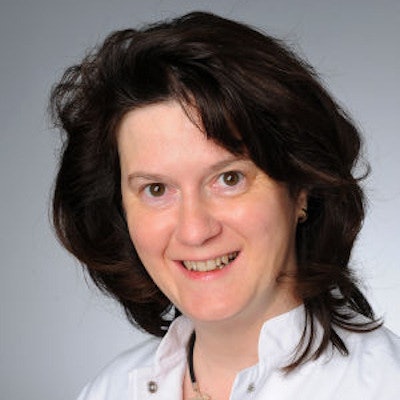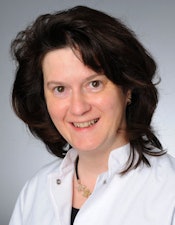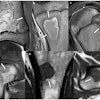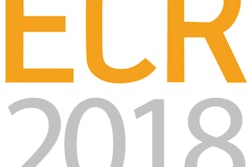
Dr. Friederike Körber has a passion for working with children. She works as head of pediatric radiology at Cologne University Hospital, and is a director of the German Röntgen Association. She was scientific manager of the annual conference of the German Pediatric Radiology Association (GPR), which took place at the Congress for Child and Adolescent Medicine in Cologne between 20 and 23 September 2017. In this interview, she talks about what makes her job so rewarding and the skills needed to make a good pediatric radiologist.
What makes pediatric radiology so special?
 Dr. Friederike Körber.
Dr. Friederike Körber.Körber: Pediatric radiologists aren't just people who are particularly good with children -- they need very special expertise. It starts with the patient spectrum, which ranges from newborn babies to young adults. As a rule, if children are treated by pediatricians, they're examined by pediatric radiologists, and we also deal with extremely premature infants who may be born halfway through pregnancy, and even before they're born, in the case of fetal MRI scans. We have to be familiar with a great variety of congenital and acquired diseases, and have a wide range of clinical and technical skills, because radiological equipment is used differently with children than with adults.
Radiological protection is particularly important because children and young people are especially vulnerable to radiation, and the dosing needs to be done on a case-by-case basis. You also have to think things through very carefully with children, and justify your decisions. For example, an ultrasound examination obviously isn't harmful, but it's still a frightening experience for some young children. And when you use big machines like CT and MRI units, you need to show empathy toward the parents as well, because they may project their anxiety onto their children.
Do pediatric radiologists need specific psychological skills more than other radiologists?
Exactly. You can't just put a child in a CT scanner without explaining exactly what's going to happen. This isn't just "feel-good" medicine, it's a highly specialized discipline that requires a very good bedside manner. One challenge is that examination and diagnosis are more time-consuming; sometimes it takes longer to prepare the child to tolerate these procedures than to carry them out.
That's what's so special about our job: You need comprehensive medical and technical expertise, but you also have to be a people person. That sometimes doesn't get enough emphasis in adult radiology, but in pediatrics we don't have a choice: If we don't put ourselves in the shoes of the patients and their relatives, the examination simply won't work.
So you have to pay a lot of attention to the parents when their children are being examined?
Absolutely, and it's often difficult for colleagues who are just starting their training. We have to justify to parents what we're doing because they quite understandably want to know every detail of their child's examination and diagnosis. In adult radiology, you do this, but the job of explaining the findings is normally left to the doctor. In our case, that's often not possible, so we need good communication skills and a detailed knowledge of the illness so we can also explain the implications of the diagnosis.
How is this service provided in Germany? Do most pediatric radiologists work in practices or hospitals?
Hospitals, definitely. A lot of large children's hospitals in Germany have pediatric radiology departments, and as far as I'm aware there are only a few specialist independent practitioners. Also, very few pediatric radiologists have teaching qualifications, which is often a problem.
What about radiology assistants? Do they need special training to work with children?
There's no specific training for them, but they do need specialist skills and a listening ear. They receive intensive in-house training to deal with children, using the equipment on them, and providing the right degree of radiological protection.
Cologne is particularly well off in this respect, having two pediatric radiology departments.
That's right. There's one at the Städtische Klinik Amsterdamer Strasse, headed by Dr. Martin Stenzel, and another at Cologne University Hospital.
How important is working with colleagues in other medical disciplines?
On a day-to-day basis, I deal at least as much with pediatricians as I do with radiologists. We discuss the different examination options, and we make a joint decision about the best diagnostic pathway for each individual patient. We talk about the indications for the use of x-ray and the detailed procedure for each CT scan and MRI, as well as hold meetings with clinicians to discuss the findings. In the case of x-ray and ultrasound, the pediatric radiologist is often the primary person to explain the diagnosis to the parents.
Cologne University Hospital also has Germany's first certified pediatric oncology department. In order to establish one of these, a certain number of pediatric radiologists on tumor boards is needed. Another of our specialties in Cologne is bone imaging, and we have a unit specializing in rare pediatric skeletal disorders. Hospitals from all over Germany draw on our skills and facilities, and regularly send us questions and images.
One of the main themes of the 2017 GPR conference was chronic disorders in children. A particularly relevant one for pediatric radiology is brittle bone disease; we have about 250 patients with this, and we're the main center in Germany. The patients' spinal columns are x-rayed once a year, but in Cologne we use very advanced dual-energy x-ray absorptiometry, which drastically reduces the radiation dose. We have a permit to do this, and it applies only to these specific cases and can't be used in other areas.
We're delighted to have shared our expertise in chronic pediatric disease with colleagues in other specialist areas at the conference.
For the first time, the annual conference of the GPR formed part of the Pediatric Medicine Congress. The event was held jointly with the German Children's Healthcare Association, the German Society for Child Surgery, the German Society for Social Pediatrics and Adolescent Medicine, and the German Society for Child and Adolescent Medicine.
Editor's note: This is an edited version of a translation of an article published in German online by the German Radiological Society (DRG, Deutsche Röntgengesellschaft). Translation by Syntacta Translation & Interpreting. To read the original article, click here.



















